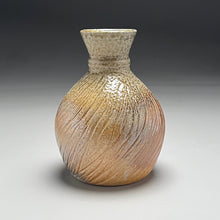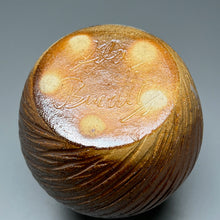This Combed Bottle in Ash and Salt Glazes can be used for fresh or dried flowers. A unique ornamental vase that will add a rustic elegance to your home or office. A beautiful example of "letting the kiln be the paintbrush". Measuring 4.5"w x 6.25"h.
Please Note: What appear to be white spots on the surface are reflections from photo lighting.
Natural Ash
The Natural Ash Glaze is produced by relying on the wood-firing process as the glazing agent. Most pieces dedicated to this glaze are placed in the kiln with little or no glaze applied to the exterior. During the firing process, the wood is stirred occasionally in the firebox to give flight to the flakes of ash that are produced during the firing. When these small flakes become airborne, they cling to the exposed areas of the pots and accumulate over a period of time. As the kiln reaches about 2300 degrees Fahrenheit, the wood ash will liquify and begin to run down the side of the pots, as if one had poured honey on the vase.
Salt Glaze
Salt Glaze was first discovered by German potters in the late 14th century. Due to the high firing temperatures, stoneware clays are required. The pieces can be handled and decorated with clay slips of many different colors, or, glazed partially with Cobalt Blue Glaze. The surface may resemble the texture of an orange peel. This was an early glaze used by settlers during the 19th century in the Seagrove area. Many of the pieces Ben makes in Salt Glaze are functional, even the more decorative large-scale pots.
Silas Bradley
An apprentice at Ben Owen Pottery since August 2025, Silas crafts a variety of wares for the Tableware Collection. In addition to crafting work for the Pottery, Silas continues to create his own ware, focusing on stoneware pieces rendered unique through the raw unpredictability of atmospheric firings.
A native North Carolinian, Silas Bradley grew up in Clinton and discovered his passion for clay at a young age. Beginning his first apprenticeship at age 16 in Burgaw, NC, Silas immersed himself in the world of clay. This time exposed him to a wide variety of methods and techniques that sparked the development of Silas’ own voice in clay. Having worked in Texas and Montana making pots, Silas settled back in his home state to work further with the practices and traditions of Seagrove.
Silas is part of a new generation of North Carolina potters, eager to converse with longstanding traditions of craftsmanship while paving the way for new creations; with deep respect for tradition, Silas crafts pieces that evoke history and practice. Creating honest forms that are both familiar and new, Silas attempts to write a further line in the continuing story of North Carolina clay.
This piece is hand-signed by Silas Bradley (either “Silas” or “Silas Bradley”).








